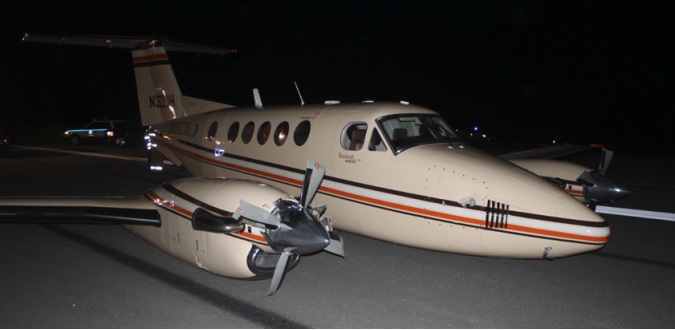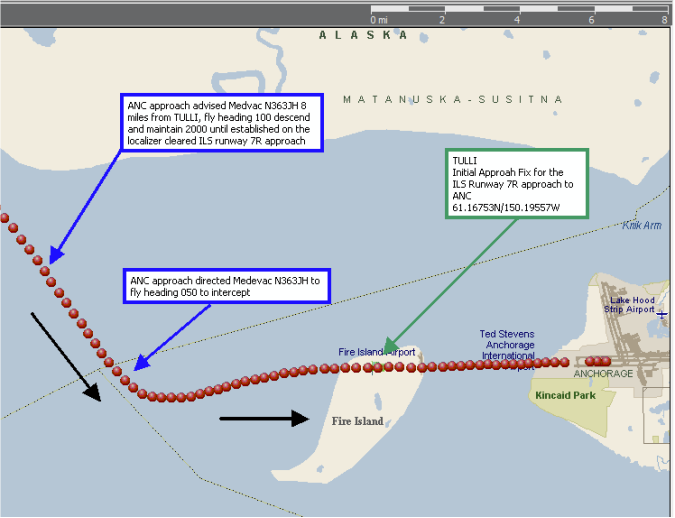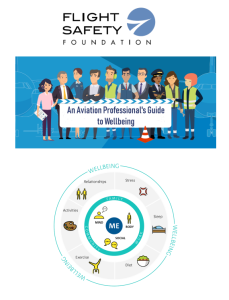Fatigue Featured in Anchorage Alaska Air Ambulance Accident (Bering Air Beechcraft King Air 200 N363JH)
On 21 October 2017, at c0530 Local Time, Beechcraft King Air 200 N363JH, operated on a Part 135 Air Ambulance flight by Bering Air, was damaged in an unintentional gear-up landing at the Ted Stevens Anchorage International Airport (ANC), Alaska. The pilot, two flight medics and medevac patient were uninjured.
History of the Accident Flight
The US National Transportation Safety Board (NTSB) explain in their safety investigation report (issued 29 June 2020) that the aircraft had departed for Anchorage from the Nome Airport, Nome (OME), Alaska, about 0320 on a inter-hospital patient transfer flight.
The pilot started his duty day on October 20, at 1830 at the company headquarters at OME. The medical evacuation flight was on a weather hold for several hours and the pilot got permission from the company director of operations (DO) to rest at his home about 5 minutes away. The pilot arrived at his home about 2130 and went to sleep about 2140. At 0113 on October 21, he awoke with a telephone call from the company dispatch center for a medical evacuation flight. The pilot described his sleep during the approximate 3.5-hour nap as good and added that he was “sleeping a real deep sleep.”
The pilot reported back to the company headquarters, completed his preflight duties, and the airplane departed from OME without incident. The flight from OME to the ANC Class C airspace was without incident. The pilot reported that after being handed off from the Anchorage Air Route Traffic Control Center to the Anchorage Approach Control, he received clearance to descend to 6,000 ft mean sea level (msl) followed with a vector heading and a descent clearance to 2,000 ft msl.
As he was descending through about 4,000 feet msl, he visually confirmed the airport and requested a visual approach. He reported the air traffic controller didn’t respond to his request, and he requested a visual approach again. The controller responded back with a vector for the instrument landing system (ILS) runway 7 right approach. The pilot reported his groundspeed was about 210 kts indicated airspeed, he joined the final approach course, and was cleared to land. He reported he believes he was given a vector heading that was too close to the final approach fix and the airplane went through the final approach fix. The pilot then received another heading and he re-established himself on the final approach course.
For the landing, the pilot selected the approach flaps setting. He reported he failed to visually check and confirm for the three-landing gear down and locked indication lights in the cockpit. Upon touchdown on the runway with the landing gear not extended, the airplane skid on the pod installed on the underside of the fuselage along with the two engine nacelle assemblies on each wing.
During the landing sequence, the metal 4-blade Hartzell HC-E4N-3G propellers for each engine separated about midspan due to runway impact damage… The right side forward fuselage sustained minor damage from various separated propeller blade debris impacts. The airplane came to rest on the runway, and the occupants egressed without further incident. The airplane was recovered and transported to secure location for a comprehensive damage assessment. The airplane sustained substantial damage to the right engine mount…
The Bering Air director of maintenance reported that after an internal inspection of both Pratt & Whitney Canada PT6A-61 turbo prop engines, it was determined that it was not economically feasible to repair both engines as two new engines were purchased instead.
NTSB Safety Investigation
Aircraft
The aircraft was not equipped, nor required to be equipped with either a Cockpit Voice Recorder (CVR) or a Flight Data Recorder (FDR). It was established there were no aircraft malfunctions. The landing gear lever was however found in the down position, something not explained by NTSB.
Air Traffic Control (ATC)
A review of ATC services provided by A11 and Anchorage ATCT to the pilot indicated no deficiencies with established air traffic control (ATC) procedures as defined in FAA Order 7110.65, Air Traffic Control. The pilot’s statement that he requested a visual approach to runway 7 right on two occasions was not supported by the recorded ATC transmissions between the pilot and the ATCT controller.
Pilot History
The 57-year-old pilot’s flight time was as follows:
23121 hours (Total, all aircraft), 662 hours (Total, this make and model), 14746 hours (Pilot In Command, all aircraft), 208 hours (Last 90 days, all aircraft), 58 hours (Last 30 days, all aircraft), 2 hours (Last 24 hours, all aircraft)
In relation to training:
A review of the company’s pilot training records revealed the pilot received basic indoctrination training on November 11, 2014, with the latest recurrent basic indoctrination training being received on December 22, 2016. The pilot received initial RAC B200 ground curriculum training on March 13, 2016. The pilot received the latest recurrent RAC B200 [Beech KA200] ground curriculum training on December 29, 2016.
In relation to duty and rest prior to the accident:
On October 19, the pilot reported he went to sleep at 1000 and woke up about 1400. He took a nap from 1700 to 1800. He went on duty at 1935 and was off duty at 0925 on October 20. On October 20, the pilot reported he went to sleep at 1000, but did not recall when he awoke. He reported sleeping again from about 2140 on October 20, to 0113 on October 21. A review of the company’s flight and duty records revealed the pilot worked the two days prior to the accident, but not did perform flight duties. The preceding three and four days prior to the accident, the pilot flew a total of 8.1 hours. The preceding fifth and sixth days prior to the accident, the pilot worked but did not perform flight duties. The remaining preceding days in the month of October 2017, the pilot was on vacation.
The pilot did not recall whether he had received any training on fatigue management, circadian rhythms, or sleep disorders since he has been employed at Bering Air. A Federal Aviation Administration (FAA) review of the pilot’s FAA medical records found no reported or diagnosed issues with fatigue or sleeping. The pilot reported he had no difficulties falling asleep, but he might “occasional get an interruption”. He would take naps while on duty while waiting for a flight to be assigned. He further reported he has never “nodded off” or fallen asleep in the airplane while performing the duties as a pilot.
Pilot Interview
During a post-accident interview, the pilot stated that he, “… felt real good flying the airplane from Nome to Anchorage. Just the fatigue started to set in when I was coming in the outer ring of the Class C airspace into Anchorage.” He added, “I feel like my judgment was impaired at the end of the flight.”
The pilot accepted responsibility for the accident and, to his credit, reflectively identified five mitigating factors:
1. Long duty period (13 hours). I felt clear and alert at the beginning of the flight, however my alertness began to diminish at the beginning of the arrival phase of the flight.
2. I failed to manage my rest accordingly.
3. I failed to manage the cockpit accordingly. Had I selected flaps beyond approach flaps I would have received a gear handle light and a warning horn.
4. I failed to check for the 3 gear down and locked lights.
5. I am feeling very comfortable in the BE20 [KA200]; however, I allowed for complacency to set in.
The pilot added
Please understand that I am not trying make up excuses for the incident or accident. However, I have been replaying in my mind over and over what occurred I am focused on getting back to one the most important preflight item; and that is “the preflight of myself”.
He also sensibly identified the following for a personal wellness check, to help determine personal readiness:
- Did I get enough rest?
- Am I hydrated enough?
- Are there problems at home?
- Are there problems with work?
- Have you consumed Alcohol within the last 12 hours?
- Are you using any prescription drugs? (most are a no-go)?
- Do I feel fatigued?
However, there are systemic organisational issues to consider.
Organisational
Bering Air neither used, nor was required to use a pre-flight risk analysis for fixed wing air ambulance flights. 14 CFR 135.617 requires a formal pre-flight risk analysis for rotary wing air ambulance flights only. The NTSB noted that:
Required topics in the pre-flight risk analysis include areas such as flight considerations, human factors, weather, etc.
The FAA explained to the NTSB that:
Helicopter air ambulance (HAA) aircraft routinely operate in to and out of off-airport landing sites [and] are also often conducted under VFR in remote areas. Fixed-wing air ambulance operations, on the other hand, are generally conducted at the same airports other non-air ambulance (air carrier and general aviation) aircraft normally operate to or from. Since the risk for fixed-wing air ambulance operations is generally no greater than other non-air ambulance operations conducted under part 135, a requirement for a formal risk analysis program is not presently required by regulation.
The FAA do not appear to have considered the long stan-by short notice, potentially ‘out of hours’, poor weather and high-pressure taskings of medevac flights
The FAA noted that 14 CFR Part 135.330 Crew Resource Management (CRM) Training states “each certificate holder must have an approved crew resource management training program that includes initial and recurrent training” and provides a list of topics to cover (emphasis added):
- Authority of the pilot in command;
- Communication processes, decisions, and coordination, to include communication with Air Traffic Control, personnel performing flight locating and other operational functions, and passengers;
- Building and maintenance of a flight team;
- Workload and time management;
- Situational awareness;
- Effects of fatigue on performance, avoidance strategies and countermeasures;
- Effects of stress and stress reduction strategies; and
- Aeronautical decision-making and judgment training tailored to the operator’s flight operations and aviation environment.
NTSB observe that:
A review of the Bering Air Training Manual, which is approved by the FAA, lists the required training areas for basic indoctrination.
These were:
- Situational awareness and the error chain
- Communications
- Workload assessment and time management
- Reliance on automation
- Stress
The required training areas for the KA200 ground curriculum were slightly expanded:
- Situational awareness and the error chain
- Stress
- Communications
- Synergy and crew concept
- Workload management
- Decision making
- Advanced/automated cockpit
Neither course covered fatigue. When NTSB asked the Director of Operations (DO) for any…
…separate documents (such as presentations, handouts, etc.) that are used to train about the effects of fatigue on performance, fatigue avoidance strategies, and fatigue countermeasures for their pilots. The DO responded that, “we have no other training programs than what is in the training manual.”
Fatigue Background
The FAA has published Advisory Circular (AC) 120-100 Basics of Aviation Fatigue. This document discusses the fundamental concepts of human cognitive fatigue and how it relates to the safe performance of duties by employees in the aviation industry. This document defines fatigue and cognitive performance and states:
Fatigue refers to a physiological state in which there is a decreased capacity to perform cognitive tasks and an increased variability in performance as a function of time on task. Fatigue is also associated with tiredness, weakness, lack of energy, lethargy, depression, lack of motivation, and sleepiness.
Cognitive performance refers to the ability to process thought and engage in conscious intellectual activity, e.g., reaction times, problem solving, vigilant attention, memory, cognitive throughput. Various studies have demonstrated the negative effects of sleep loss on cognitive performance.
Fatigue associated with aviation operations is a risk factor for occupational safety, performance effectiveness, and personal wellbeing. The multiple flight legs, long duty hours, limited time off, early report times, less-than-optimal sleeping conditions, rotating and non-standard work shifts, and jet lag pose significant challenges for the basic biological capabilities of pilots, crewmembers and shift workers. Humans simply are not designed to operate effectively under the pressured 24/7 schedules that often define aviation operations, whether the operations are short-haul commercial flights, long-range transoceanic operations, or around-the-clock and shift work operations.
NTSB Analysis
Evidence indicates that the accident occurred during the window of circadian low, and the pilot’s sleep periods were fragmented in the days before the accident and he did not have a contiguous 8 hours of sleep that was typical of his sleep pattern when not working overnight periods; both of these factors likely contributed to the pilot being fatigued about the time of the accident.
The pilot reported that he felt the effects of fatigue, including impaired judgment, as he approached the destination airport.
The pilot’s readback errors and his failure to extend the landing gear are consistent with performance degradation due to fatigue. The pilot cited being on a long duty period, failing to manage his rest, failing to manage the cockpit, and allowing complacency to set in as factors that affected his performance.
NTSB Probable Cause
The probable cause was the relatively un-insightful:
The pilot’s failure to extend the landing gear before landing, which resulted in a gear-up landing.
However, more insightfully:
Contributing to the accident was the pilot’s fatigue and complacency.
Safety Resources
HindSight 30 focused on the theme of Wellbeing.
The Flight Safety Foundation (FSF) has recently published An Aviation Professional’s Guide to Wellbeing.
This has been written based on the ‘BioPsychoSocial Model of Health’:
On fatigue and personal readiness we have previously written:
- Fatigued Flight Test Crew Superjet 100 Crosswind Accident
- Embraer ERJ 170 FMS Error & Fatigue
- Asiana B777 Accident at SFO 6 July 2013
- Survey Aircraft Fatal Accident: Fatigue, Fuel Mismanagement and Prior Concerns
- Perception and Fatigue: CH124 Sea King Engine Failure
- Maintenance Personnel Fatigue and Alertness
- UPDATE 26 September 2020: Fatal Fatigue: US Night Air Ambulance Helicopter LOC-I Accident
- UPDATE 31 October 2020: Loss of Control During HESLO Construction Task: BEA Highlight Wellbeing / Personal Readiness
- UPDATE 16 May 2021: Cessna 208B Collides with C172 after Distraction
We have discussed human factors and error management more generally here:
- Professor James Reason’s 12 Principles of Error Management
- Back to the Future: Error Management
- Rockets Sleds, Steamships and Human Factors: Murphy’s Law or Holt’s Law?
- Complacency: A Useful Concept in Safety Investigations?
- Also see our review of The Field Guide to Understanding Human Error by Sidney Dekker presented to the Royal Aeronautical Society (RAeS): The Field Guide to Understanding Human Error – A Review
Also see:
There are videos online of other King Air / B1900 family wheel up landings:
Aerossurance was to have run workshops at the EHA European Rotors VTOL Show and Safety Conference in Cologne in November 2020 on a) Safety Culture and Leadership and b) Contracting Aviation Services: An Introduction to the Basics. Sadly this has been postponed due to COVID-19.







Recent Comments